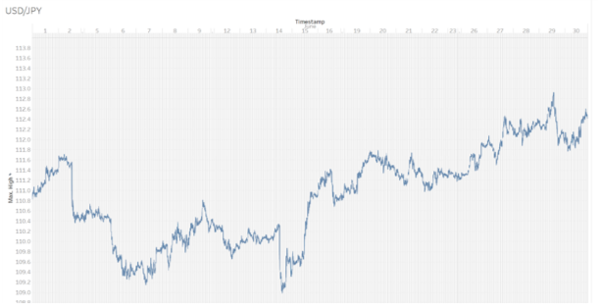Difference between revisions of "ANLY482 AY2017-18T2 Group06 Analysis Findings"
| Line 31: | Line 31: | ||
| | ||
<div>__TOC__</div> | <div>__TOC__</div> | ||
| − | ==<div style="background: #708090; line-height: 0.5em; font-family:'Century Gothic'; border-left: #2E5593 solid 15px;"><div style="border-left: #FFFFFF solid 5px; padding:15px;font-size:15px;"><font color= "#F2F1EF">DATA | + | ==<div style="background: #708090; line-height: 0.5em; font-family:'Century Gothic'; border-left: #2E5593 solid 15px;"><div style="border-left: #FFFFFF solid 5px; padding:15px;font-size:15px;"><font color= "#F2F1EF">DATA CLEANING AND PREPARATION</font></div></div>== |
| + | |||
| + | For our data cleaning and preparation, we used the following software to both visualize and ETL the data into other forms: | ||
| + | 1. JNP Pro | ||
| + | 2. Tableau | ||
| + | 3. SQL Server Data Tools 2015 (MSSQL) | ||
| + | 4. Microsoft Excel | ||
| + | |||
| + | Through the visualization seen earlier in the report, we realized that there is a need to perform data transformation to visualize all the data. Therefore, the data was prepared with MSSQL instead to produce a ‘day aggregated’ data-set for analysis on the day-time period basis. | ||
| + | |||
| + | Our initial methodology was to use the clustering method to identify clusters which could be treated as baskets for investment. As the currency values of USDJPY and the rest are vastly different, there was a need to transform into percentage change and standard deviation for clustering. | ||
| + | |||
| + | However, our client does not have 15-20 or more currency pairs in their database. Hence, we would be focusing on forecasting with these 5 currency pairs. Our team used the ARIMA forecasting method and thus the data transformation method would not be required as the ARIMA model uses its own unique method to transform data. | ||
| + | |||
| + | The image below shows the result of our first data transformation. | ||
| + | [[Image:Data5.PNG|centre|600px|]] | ||
| + | |||
| + | We performed data transformation to allows us to visualize the data differently and derive new insights on the data: | ||
| + | [[Image:Data5.PNG|centre|600px|]] | ||
| + | [[Image:Data5.PNG|centre|600px|]] | ||
| + | |||
| + | As seen in the visualization of the data of the same currency pair and time period, we can see the trends and price movements for the entire time period of 2 years for USDJPY data. | ||
| + | |||
| + | This provided additional data discoveries which we observe significant shifts in the price movements and their variations throughout the time period. This allows us to visually compare across multiple currency pairs to spot any prominent similarities and trends between them. | ||
| + | Although nothing of significance was identified through the visualization charts as shown below, we could identify periods of time which could increase the granularity of the data points to allow deeper analysis for our forecasting. | ||
| + | |||
| + | ==<div style="background: #708090; line-height: 0.5em; font-family:'Century Gothic'; border-left: #2E5593 solid 15px;"><div style="border-left: #FFFFFF solid 5px; padding:15px;font-size:15px;"><font color= "#F2F1EF">DATA VISUALISATION</font></div></div>== | ||
| + | |||
| + | | ||
<!--Body End--> | <!--Body End--> | ||
Revision as of 22:24, 25 February 2018
|
|
|
|
|
|
|
|
DATA CLEANING AND PREPARATION
For our data cleaning and preparation, we used the following software to both visualize and ETL the data into other forms: 1. JNP Pro 2. Tableau 3. SQL Server Data Tools 2015 (MSSQL) 4. Microsoft Excel
Through the visualization seen earlier in the report, we realized that there is a need to perform data transformation to visualize all the data. Therefore, the data was prepared with MSSQL instead to produce a ‘day aggregated’ data-set for analysis on the day-time period basis.
Our initial methodology was to use the clustering method to identify clusters which could be treated as baskets for investment. As the currency values of USDJPY and the rest are vastly different, there was a need to transform into percentage change and standard deviation for clustering.
However, our client does not have 15-20 or more currency pairs in their database. Hence, we would be focusing on forecasting with these 5 currency pairs. Our team used the ARIMA forecasting method and thus the data transformation method would not be required as the ARIMA model uses its own unique method to transform data.
The image below shows the result of our first data transformation.
We performed data transformation to allows us to visualize the data differently and derive new insights on the data:
As seen in the visualization of the data of the same currency pair and time period, we can see the trends and price movements for the entire time period of 2 years for USDJPY data.
This provided additional data discoveries which we observe significant shifts in the price movements and their variations throughout the time period. This allows us to visually compare across multiple currency pairs to spot any prominent similarities and trends between them. Although nothing of significance was identified through the visualization charts as shown below, we could identify periods of time which could increase the granularity of the data points to allow deeper analysis for our forecasting.
DATA VISUALISATION

